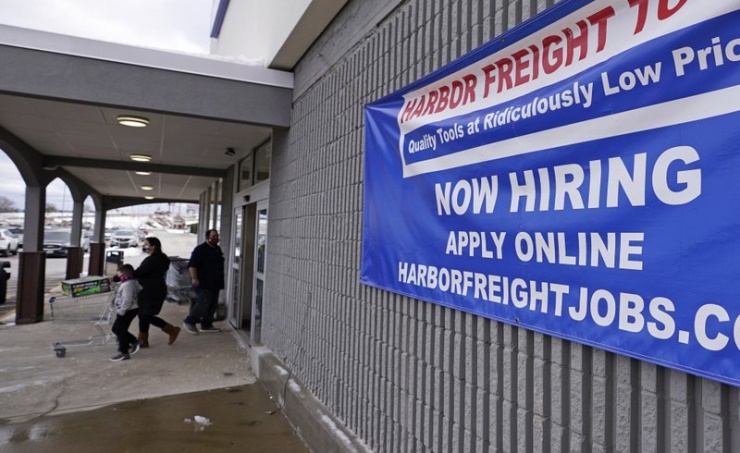The number of Americans seeking unemployment benefits last week fell by 19,000 to 787,000, still a historically high level as a resurgent coronavirus maintains its grip on the U.S. economy.

While at the lowest level in four weeks, the figures released Thursday by the Labor Department are nearly four times higher than last year at this time before the coronavirus struck. Employers continue to cut jobs as rising infections keep many people at home and state and local governments re-impose tighter restrictions on businesses and public activities, The Associated Press (AP) reported.
Jobless claims were running around 225,000 per week before the pandemic struck with force last March when weekly jobless claims surged to 6.9 million and sent U.S. economy into a deep recession.
The total number of people receiving traditional unemployment benefits fell by 103,000 to 5.2 million for the week ending Dec. 19. That’s still far greater than the 1.7 million a year ago when the unemployment rate was hovering around a half-century low of 3.9%.
Unemployment claims peaked in May at 25.9 million.
The four-week average for claims which smooths out weekly variations rose last week to 836,750, an increase of 17,750 from the previous week.
Economists believe that the holidays, in addition to broad confusion over the status of a COVID-19 relief package, suppressed applications for benefits last week, so the numbers may be worse than they appear.
Congress finally passed a $900 billion relief bill that would boost benefit payments and extend two unemployment assistance programs tied to job losses from the pandemic. However, President Donald Trump called the measure a “disgrace” and refused to sign off until Sunday, a one-week delay that means many Americans in desperate need will have to wait longer for help.
Trump has continued to pressure Congress, through tweets, to boost the stimulus payments to individuals from the $600 in the bill to $2,000. The Democratic-controlled House quickly passed legislation to meet Trump’s demand, but the Republican-led Senate checked that effort.
Senate Majority Leader Mitch McConnell blocked the measure and said Wednesday that the proposal to boost payments to $2,000 has “no realistic path to quickly pass the Senate.”
Meanwhile, the government has begun sending out the smaller payments to millions of Americans. The $600 payment is going to individuals with incomes up to $75,000.
Some Americans should begin seeing the stimulus payments this week. The payments are being automatically distributed with no action required for people who qualify.
Analysts believe the $900 billion package as it now stands will give the economy a boost, but only as long there are no major problems with the rollout of COVID-19 vaccinations.
Earlier this month, the Trump http://www.businesstoday.me/wp-content/uploads/2022/12/sample10.jpgistration said it planned to have 20 million doses of the vaccine distributed by the end of the year, but according to data provided by the Centers for Disease Control, just over 11.4 million doses have been distributed and only 2.1 million people have received their first dose.
Trump deflected criticism about the pace of the vaccine program, saying that it’s “up to the States to distribute the vaccines.”
Andrew Stettner, senior fellow at The Century Foundation and an expert on unemployment benefits, said, “With fears of a new, more contagious strain of the virus spreading, the labor market badly needs a swifter implementation of the vaccine program in order to safely re-open the economy in 2021.”
Most economists had expected the U.S. economy to rebound at some point next year, but that depends on the U.S. response to the coronavirus.
“While prospects for the economy later in 2021 are upbeat, the economy and labor market will have to navigate some difficult terrain between now and then and we expect (jobless) claims to remain elevated,” said Nancy Vanden Houten, lead U.S. economist at Oxford Economics.
Thursday’s jobless claims report showed that the two special unemployment assistance programs that have been renewed through mid-March by the new $900 billion virus relief package remained at elevated levels.
The Pandemic Unemployment Assistance program, which provides benefits for the self-employed and others not normally eligible for jobless aid, saw a drop of 811,465 to 8.5 million for the week ending Dec. 12. The other special Pandemic Emergency assistance program, which provides up to 13 weeks of additional payments for individuals who have exhausted their regular state benefits, saw a drop of 20,377 to 4.8 million.
The new COVID-19 relief bill extends both programs, which had expired last week, until mid-March.
The total for all unemployment assistance programs was 19.6 million for the week ending Dec. 12, down 799,841 from the previous week. Analysts said that this drop represented some people who were able to find work but a larger number who have exhausted their benefits.
“While the job prospects for 2021 are brighter, it will take the first half of the year for that momentum to build,” said Greg McBride, chief financial economist at Bankrate. “Elevated unemployment will be with us long after the virus is vanquished.”
The government will report next week on the unemployment picture for December. Economists for JPMorgan expect the jobless rate in December to stay at 6.7%, where it had dipped in November, but for employers to shed 25,000 jobs. That would mark the first setback in monthly job growth since the economy started climbing out of the virus-triggered recession last spring.












